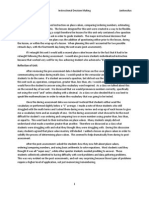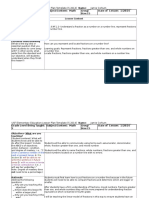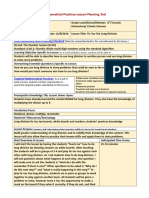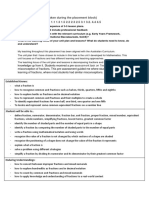Tws 4 Assessment Plan
Tws 4 Assessment Plan
Uploaded by
api-177752973Copyright:
Available Formats
Tws 4 Assessment Plan
Tws 4 Assessment Plan
Uploaded by
api-177752973Original Title
Copyright
Available Formats
Share this document
Did you find this document useful?
Is this content inappropriate?
Copyright:
Available Formats
Tws 4 Assessment Plan
Tws 4 Assessment Plan
Uploaded by
api-177752973Copyright:
Available Formats
Brett Jankouskas
Teacher Work Sample #4
March 28th, 2014
Assessment Plan Showcase Lesson Overview: My showcase lesson is a three part lesson introducing fractions in mathematics. This lesson involves a non-graded pre-assessment quiz that is also the post-assessment. Using this quiz as both the pre and post-assessments will give me the most consistent gauge of student learning. My objective is the following; When given an equation consisting of standard operations and fractions, students will demonstrate their understanding by solving the mathematical equation with 100% accuracy. This objective is in line with Common Core standard 4.NF.3: Build fractions from unit fractions by applying and extending previous understandings of operations on whole numbers. Lesson Objective Assessment Types Formative Assessments Pre-assessment: Four question quiz. Post-assessment: Four question quiz (same as pre-assessment). Accommodations Any student who is having difficulty seeing, paying attention, or taking notes will be welcomed to the carpet. If students are not grasping the material, extra instruction will be given in the most appropriate manner (whole class/individual). I will read and re-read any questions aloud both on the quiz and during instruction for all students understanding (One ESL student).
When given an equation consisting of standard operations and fractions, students will demonstrate their understanding by solving the mathematical equation with 100% accuracy.
Pre-assessment During-assessment Post-assessment
I will be using the students McGraw-Hill mathematics text books throughout the three lessons. My cooperating teacher uses them every day for their math notes and homework. This will keep the students sense of consistency. I will be adding group work, team competitions, and manipulates. Group work is often used in this classroom due to the classroom community
1
Brett Jankouskas
Teacher Work Sample #4
March 28th, 2014
being positive and supporting. My class also has fraction tiles and pie pieces for each student to use with their hands. My personal touch to the lessons will be a constant encouragement of using manipulates, an exploring period before the lesson starts with manipulates, and a team competition at the end of each lesson. The team competition will allow the students to test their skills with one another. It also will encourage engagement throughout the lesson due to the fact that the students know they are going to compete against one another soon. Each lesson will consist of a review where as a class we will state the objective. We will also review the previous lessons material and vocabulary, such as; operation, unit fraction, whole number. After the reviews we will move into the book note taking. The book is set-up in an I do-We do-You do format. I will walk students through a couple of problems (everyone reading aloud), then have them assist me, and finally conclude with the students individually working. Students will then work in groups to answer the questions I pose. These will be of my own creation at the time of the lesson. Example: + =? Students will answer these questions on group white boards. Then we will turn this group work into a competition each lesson. The fastest team will get a Starbuck (Lakeview Elementary token reward). The lesson will conclude with a wrap-up of that lessons new content and of the previous lesson or lessons. Examples: What is an operation?, Who can tell me the standard procedure for adding two like-fractions?, and How do I know if the fraction is simplified? Assessment Characteristics: The pre-assessment and post-assessment quiz can be found in figure 1 on page 5. This quiz consists of an addition fraction equation and a subtraction fraction equation. There are also two short-answer, definition based questions on two vocabulary words that we will use throughout the week (like fraction and unit fraction). This assessment is appropriate not only with the standards addressed in Common Core (4.NF.3), but also with the students development and cognitive levels. These two assessments will be scored as a quiz which is one hundred points, but weighted as thirty percent of one hundred. The pre-assessment will not be recorded as a grade, but handed back to the students to correct over the next two lessons. The results will be recorded by the number of questions the student answered correctly (0-4). The postassessment will be recorded as a quiz grade. Each question is worth twenty-five of the total one hundred, then weighted as thirty percent. The during-assessment will be performed each day in the form of teacher observations. This will be informal note taking by the instructor on what material students seem to be having difficulty with (Figure 2 page 6). Students will not receive a grade for this, not even participation. This is mainly for the teacher gauging the students understanding. I will score the students on a table on what level their understanding seems to be (1, 2, or 3; a 3 being on par for mastery). I will do this each day and compare the results after the lesson. For any subject matter that students are struggling with, extra instruction or personalized instruction will be given when appropriate. For example is the entire class is struggling I will play the songs provided by the
2
Brett Jankouskas
Teacher Work Sample #4
March 28th, 2014
McGraw-Hill connect website and provide each student with a copy of the lyrics to follow allow. If a single student or a small group of students are having difficulty then I will assist them in a more individualized manner, such as; bring them to the back table with manipulates and white boards for personal instruction. I chose an informal during-assessment because students may not grasp the material until the last lesson, this would then be inappropriate or unfair to them if graded during the second lesson, or halfway through the lessons. Possible Lesson Adaptations: Students may not grasp the idea of fractions not consisting of whole numbers, but of parts of whole numbers due to the abstract nature of such a thought. This means that fractions are not concrete and friendly numbers. If at any point during the instruction portion of the lessons students are not grasping the material we will take a short break where students will get out of their seats and we will play a game called Buzz. During this game I will consult with my cooperating teacher on another approach to the lesson. This game is a mental math game that will take around five to ten minutes (once a lesson at most). There may not be a winner if ten minutes is reached before one is declared. The competition at the end of the lesson will be compromised if Buzz uses too much time and a new subject must be started. Buzz This game has students get into a circle and count off from one onward; One, two, three, etc At the beginning of the game we as a class will choose a number under ten. Example: We choose the number three, which means students must say buzz on every number that is a multiple of three and has a three in it. Therefore the dialogue would be one, two, buzz, four, five, buzz, seven, eight, buzz, ten, eleven, buzz, buzz. If you get one wrong you are out and are skipped on the next round. After someone gets out a new number is picked and you start the count over. After five minutes of this brain activity we will go back into the lesson and approach the material from a different angle that I have discussed with my cooperating teacher. When individual or group instruction is in motion and one or the other is not grasping the content I will individually assist that student or group. I will use a more hands-on approach that involves the students showing me with manipulates how to represent fractions. Then I will scaffold them into answering operation equations such as + =? If the students are still unable to understand the concepts I will ask for assistance from my cooperating teacher. Assessment Purposes: My plan for using the pre-assessment (Figure 3 page 7) is to create a benchmark of where each students mathematical understanding is at, whether they are under par, on par, or exceeding standards. This will help me predict which parts of each lesson the students will
3
Brett Jankouskas
Teacher Work Sample #4
March 28th, 2014
either grasp quickly or need extra time to master. Ultimately this information gives me a means for making these three lessons go as efficiently and successfully as possible. This preassessment will guide the time I take in each part of each lesson for the three day unit. This is of course assuming that the pre-assessment is a non-bias measure of each students current understanding. The during-assessment will point to what areas of the subject matter I need to revisit or if every student has achieved mastery at a certain part it will allow us to move on with the material. This assessment must therefore be informal and not graded. Having the students understand these lessons and achieve mastery of the objective is meant for at least three lessons, and would therefore be inappropriate to grade them during instruction. The post-assessment will be used to point out which students are still unable to grasp the material that was taught, and/or if any material needs reviewed or reexamined. This will be graded as a quiz of what each student understands after the three given lessons. If a student received a failing grade or made zero sign of understanding, then that student or students will be given further instruction specified to their individual schemata.
Brett Jankouskas
Teacher Work Sample #4
March 28th, 2014
Figure 1 Name: _____________________________ Date: ________________
Solve both fraction equations and put them in simplest form.
5/6 + 3/6 =_________
7/8 1/8 =_________
Write a short definition OR a brief description of each word. Unit-fraction: ______________________________________________________________________________ ______________________________________________________________________________ ______________ Like-fraction: ______________________________________________________________________________ ______________________________________________________________________________ ______________
Brett Jankouskas
Teacher Work Sample #4
March 28th, 2014
During-Assessment Checklist: Student 1 2 3 4 5 6 7 8 9 10 11 12 13 14 15 16 17 18 19 20 21 22 23 1 2 3
Brett Jankouskas
Teacher Work Sample #4
March 28th, 2014
Pre-Assessment Results: Student 1 2 3 4 5 6 7 8 9 10 11 12 13 14 15 16 17 18 19 20 21 22 23 0 X X 1 2 3 4
X X X X X X X X X X X X X X X X X X X X X
You might also like
- Pre-Observation Form SampleDocument3 pagesPre-Observation Form Sampleapi-274909201100% (20)
- Mastering Essential Math Skills, Book 1: Grades 4 and 5, 3rd Edition: 20 minutes a day to successFrom EverandMastering Essential Math Skills, Book 1: Grades 4 and 5, 3rd Edition: 20 minutes a day to successNo ratings yet
- BUSI 353 Assignment #6 General Instructions For All AssignmentsDocument4 pagesBUSI 353 Assignment #6 General Instructions For All AssignmentsTan0% (1)
- Maths and Science Infant Ecd - Grade 2Document35 pagesMaths and Science Infant Ecd - Grade 2hil67% (3)
- Guillain-Barré Syndrome: I. Anatomical and Physiological BackgroundDocument8 pagesGuillain-Barré Syndrome: I. Anatomical and Physiological BackgroundSteve ColbertNo ratings yet
- Content Standard(s) Addressed by This Lesson:: STEPP Lesson Plan FormDocument8 pagesContent Standard(s) Addressed by This Lesson:: STEPP Lesson Plan Formapi-285174429No ratings yet
- Tpa 1Document11 pagesTpa 1api-501103450No ratings yet
- Lesson Study (8-A)Document7 pagesLesson Study (8-A)api-268936305No ratings yet
- Looking at Things From Different Angles Lesson PlanDocument4 pagesLooking at Things From Different Angles Lesson Planapi-312817447No ratings yet
- Activities For AssessmentDocument4 pagesActivities For AssessmentHerma BackupNo ratings yet
- Math Unit: Tables, Charts, and Graphing: Section 1Document55 pagesMath Unit: Tables, Charts, and Graphing: Section 1api-211634867No ratings yet
- Stepp Review Activity 1Document6 pagesStepp Review Activity 1api-281839323No ratings yet
- Tws 4 Assessment PlanDocument5 pagesTws 4 Assessment Planapi-177752973No ratings yet
- Assessment PlanDocument16 pagesAssessment Planapi-341781271No ratings yet
- Final PbaDocument21 pagesFinal Pbaapi-269648782No ratings yet
- Lesson 3 - Interpreting Remainders NewDocument4 pagesLesson 3 - Interpreting Remainders Newapi-300666676No ratings yet
- Classroom Management PlanDocument4 pagesClassroom Management Planhoudini4No ratings yet
- Lesson 2 - Thinking Addition To 10 To SubtractDocument3 pagesLesson 2 - Thinking Addition To 10 To Subtractapi-273444334No ratings yet
- Solving Two-Step EquationDocument6 pagesSolving Two-Step Equationapi-534102323No ratings yet
- Tws 3Document3 pagesTws 3api-185932738No ratings yet
- Tws 7 Instructional Decision MakingDocument4 pagesTws 7 Instructional Decision Makingapi-177752973No ratings yet
- Tws 8 Reflection Self-Evaluation and Professional DevelopmentDocument6 pagesTws 8 Reflection Self-Evaluation and Professional Developmentapi-177752973No ratings yet
- Linear Fraction Model 3rd GradeDocument9 pagesLinear Fraction Model 3rd Gradeapi-247362755No ratings yet
- Math Unit Plan - PortfolioDocument24 pagesMath Unit Plan - Portfolioapi-543319841No ratings yet
- 8-1 Lesson PlanDocument4 pages8-1 Lesson Planapi-241830835No ratings yet
- Supervisorob 1 Reflectionl 3Document5 pagesSupervisorob 1 Reflectionl 3api-432258478No ratings yet
- Finalized Lesson PlanDocument9 pagesFinalized Lesson Planapi-265324068No ratings yet
- 10 21 Math Lesson PlanDocument2 pages10 21 Math Lesson Planapi-250081728No ratings yet
- Sanchez-Math Mini Unit Planning Guide Fall 2023Document7 pagesSanchez-Math Mini Unit Planning Guide Fall 2023laurensanchez1001No ratings yet
- Tiered Lesson Plan and AppendiciesDocument7 pagesTiered Lesson Plan and Appendiciesapi-295583127No ratings yet
- CCSS - MATH.CONTENT.4.OA.B.4 - Gain Familiarity With Factors and Multiples Find All FactorDocument3 pagesCCSS - MATH.CONTENT.4.OA.B.4 - Gain Familiarity With Factors and Multiples Find All Factorapi-450819181No ratings yet
- Lesson 3 - Thinking Addition To 10 To SubtractDocument3 pagesLesson 3 - Thinking Addition To 10 To Subtractapi-273444334No ratings yet
- BP Jeopardy Lesson PlanDocument4 pagesBP Jeopardy Lesson Planapi-271343503No ratings yet
- Ed 302 Unit Plan Lesson 4 PDFDocument4 pagesEd 302 Unit Plan Lesson 4 PDFapi-300683985No ratings yet
- Order of Operations Day 1 LessonDocument3 pagesOrder of Operations Day 1 Lessonapi-571870380No ratings yet
- MultiplicationDocument6 pagesMultiplicationRoseanna Mark0% (1)
- Assessment DescriptionDocument6 pagesAssessment Descriptionapi-244472956No ratings yet
- Tws 4 Assessment PlanDocument11 pagesTws 4 Assessment Planapi-242380700No ratings yet
- Tws 6Document6 pagesTws 6api-185932738No ratings yet
- L T 5 4 Lesson PlanDocument4 pagesL T 5 4 Lesson Planapi-298949340No ratings yet
- Direct Instruction 1Document6 pagesDirect Instruction 1api-314997078100% (1)
- Solve Real-World ProblemsDocument3 pagesSolve Real-World Problemsapi-545793045No ratings yet
- Observation #2 - Math LessonDocument5 pagesObservation #2 - Math LessonAlexandra KeresztesNo ratings yet
- Database of Effective Feedback StrategiesDocument5 pagesDatabase of Effective Feedback Strategiesapi-223530755No ratings yet
- Lesson PlanDocument4 pagesLesson Planapi-294592109No ratings yet
- Supervisor Lesson Plan - TornadoesDocument5 pagesSupervisor Lesson Plan - Tornadoesapi-247277013No ratings yet
- Mathlessondividing 2Document3 pagesMathlessondividing 2api-242288854No ratings yet
- Chapter 2 Lesson 3 Springfield-Channa GrihamDocument3 pagesChapter 2 Lesson 3 Springfield-Channa Grihamapi-175333098No ratings yet
- Lessonplantemplate Adapted MasterDocument6 pagesLessonplantemplate Adapted Masterapi-331670636No ratings yet
- Example Lesson PlansDocument15 pagesExample Lesson Plansapi-289863780No ratings yet
- Lesson PlansDocument18 pagesLesson Plansapi-594692595No ratings yet
- 4 SRT Lesson e WebbDocument2 pages4 SRT Lesson e Webbapi-346174767No ratings yet
- Vondette Lesson 1Document9 pagesVondette Lesson 1api-278009574No ratings yet
- Unit Plan Summative Assessment AnalysisDocument7 pagesUnit Plan Summative Assessment AnalysisAnonymous Z9zcD6BzNo ratings yet
- Tws 3 Assessment PlanDocument5 pagesTws 3 Assessment Planapi-176512276No ratings yet
- Field Lesson 1Document7 pagesField Lesson 1api-296414448No ratings yet
- Lesson 5Document3 pagesLesson 5api-284183356No ratings yet
- Edn Final LessonDocument3 pagesEdn Final Lessonapi-253446923No ratings yet
- MODULE 7.docx CLSDocument4 pagesMODULE 7.docx CLSrizaldorubenjr.101No ratings yet
- Lesson Plan Template - Set ProgramDocument4 pagesLesson Plan Template - Set Programapi-238367895No ratings yet
- Lesson Plan 1 DHDocument4 pagesLesson Plan 1 DHDalton HartleyNo ratings yet
- Tpa Activity 3Document3 pagesTpa Activity 3api-480040176No ratings yet
- Informational Text Toolkit: Research-based Strategies for the Common Core StandardsFrom EverandInformational Text Toolkit: Research-based Strategies for the Common Core StandardsNo ratings yet
- Tws 10 Communication and Collaboration PlanDocument5 pagesTws 10 Communication and Collaboration Planapi-177752973No ratings yet
- Tws 7 Instructional Decision MakingDocument4 pagesTws 7 Instructional Decision Makingapi-177752973No ratings yet
- Tws 8 Reflection Self-Evaluation and Professional DevelopmentDocument6 pagesTws 8 Reflection Self-Evaluation and Professional Developmentapi-177752973No ratings yet
- Tws 2 Long Range PlanDocument4 pagesTws 2 Long Range Planapi-177752973No ratings yet
- Tws 4 Assessment PlanDocument5 pagesTws 4 Assessment Planapi-177752973No ratings yet
- Tws 1 Contextual FactorsDocument6 pagesTws 1 Contextual Factorsapi-177752973No ratings yet
- Tws 1 Contextual FactorsDocument5 pagesTws 1 Contextual Factorsapi-177752973No ratings yet
- Tws 10 Communication and CollaborationDocument6 pagesTws 10 Communication and Collaborationapi-177752973No ratings yet
- Basic Skills1Document2 pagesBasic Skills1api-177752973No ratings yet
- Mr. J's Classroom Newsletter: Ack To ChoolDocument2 pagesMr. J's Classroom Newsletter: Ack To Choolapi-177752973No ratings yet
- Adobe Scan 22 Dec 2020 PDFDocument4 pagesAdobe Scan 22 Dec 2020 PDFtest2k3No ratings yet
- Exa Logic For DummiesDocument28 pagesExa Logic For DummiesMohdFaizuddinNordin100% (1)
- P2 Holiday Pack 2024 Term 3 (1)Document40 pagesP2 Holiday Pack 2024 Term 3 (1)GLOBAL CAFENo ratings yet
- Sexual JealousyDocument11 pagesSexual JealousyLip Stick100% (1)
- 336 is there a thing more dear - Full ScoreDocument1 page336 is there a thing more dear - Full ScoreRobert GiracelloNo ratings yet
- Mathematics in The Modern WorldDocument5 pagesMathematics in The Modern WorldVince BesarioNo ratings yet
- Ece-213 Lab7 10-27-2020 OwenblairDocument8 pagesEce-213 Lab7 10-27-2020 Owenblairapi-548288377No ratings yet
- Balanay Vs MartinezDocument1 pageBalanay Vs MartinezBANanaispleetNo ratings yet
- Jrotc Syllabus Sy22-23 2Document5 pagesJrotc Syllabus Sy22-23 2api-201178565No ratings yet
- 1105 Pre-Class Assignment Week 1 (Functions)Document2 pages1105 Pre-Class Assignment Week 1 (Functions)DanielaNo ratings yet
- Study Guide InteractiefDocument65 pagesStudy Guide Interactiefnqh2009No ratings yet
- Native American Art Before 1300 CeDocument60 pagesNative American Art Before 1300 Ceragunath palaniswamyNo ratings yet
- (FREE PDF Sample) Savonarola The Rise and Fall of A Renaissance Prophet 1st Edition Donald Weinstein EbooksDocument68 pages(FREE PDF Sample) Savonarola The Rise and Fall of A Renaissance Prophet 1st Edition Donald Weinstein Ebooksfibionsumiga100% (5)
- 119 DENR V YapDocument4 pages119 DENR V Yapk santosNo ratings yet
- BOIVIN PILGRIMAGEENVIRONMENT 2021 CompressedDocument45 pagesBOIVIN PILGRIMAGEENVIRONMENT 2021 Compressedmattfurly2194No ratings yet
- Gamification in The English Language Class Analysis of Pre-ServiceDocument21 pagesGamification in The English Language Class Analysis of Pre-ServicetolstoianaNo ratings yet
- Supply Chain Management Practices and Problems in A Cement Company, Philippines: Basis For An Automated System DesignDocument5 pagesSupply Chain Management Practices and Problems in A Cement Company, Philippines: Basis For An Automated System DesignarjayNo ratings yet
- Catalog OkDocument40 pagesCatalog OkScribdTranslations0% (1)
- List of School Managment Committee SMCDocument2 pagesList of School Managment Committee SMCjawedakhtar089No ratings yet
- Unit I Introduction of Value EducationDocument14 pagesUnit I Introduction of Value EducationAnirudh Guptha100% (4)
- New Format 2025Document14 pagesNew Format 2025dolarzbobo2No ratings yet
- Novho Careers: Temporary Staffing ServicesDocument18 pagesNovho Careers: Temporary Staffing ServicesnirNo ratings yet
- Relationship With The Secondary and Tertiary Stakeholders Prepared byDocument18 pagesRelationship With The Secondary and Tertiary Stakeholders Prepared byJetmark Remegio100% (3)
- Kontos A Simple Tool...Document24 pagesKontos A Simple Tool...Cindy Tero AlmonicarNo ratings yet
- 4024 Y04 SW 5Document6 pages4024 Y04 SW 5mstudy123456No ratings yet
- G.R. No. 198967, March 07, 2016 Jose Emmanuel P. Guillermo V. Crisanto P. UsonDocument9 pagesG.R. No. 198967, March 07, 2016 Jose Emmanuel P. Guillermo V. Crisanto P. UsonLily MondaragonNo ratings yet
- Contoh Soal Bahasa Inggris Sekolah Dasar (SD)Document3 pagesContoh Soal Bahasa Inggris Sekolah Dasar (SD)nuraeni1216No ratings yet
































































































